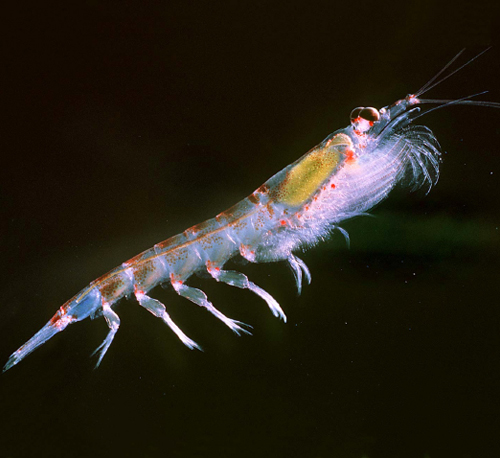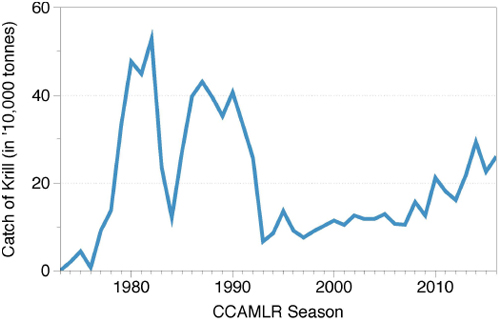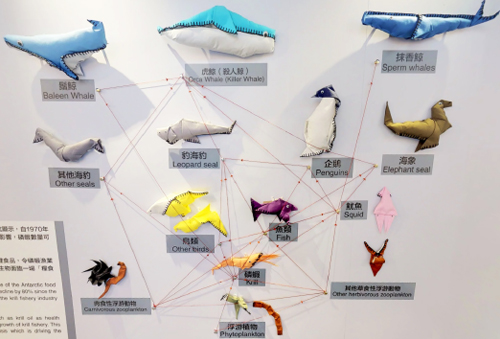Cornerstone of Antarctic Ecosystem
Human activities produce ‘excessive’ amounts of greenhouse gases. This has not simply resulted in global warming, but also threatening all animal life on the planet. In each ecosystem, each living organism has its unique role as a producer, consumer or decomposer. These roles are inter-related, forming an interlocking food web. The loss of any single role from the food web could lead to the collapse of the whole ecosystem.
In recent years, news of the effect of climate change on polar bears and penguins in the polar regions has caused widespread concern. Antarctica’s penguins are well-known, but the continent has many other species which may appear to be insignificant but are actually important to the ecosystem. They are all living under the threat of the impacts of both climate change and human activities.

The waters surrounding Antarctica are usually called the Southern Ocean, though they are also known as the Antarctic Ocean or Austral Ocean. This ocean has an area of 20,330,000 km2 (more than 7,000 times the size of Hong Kong) and is the fourth largest ocean in the world, with water temperatures ranging between 10°C and -2°C. The ocean is the home of more than 8,000 species, of which blue whales, emperor penguins, wandering albatrosses and Weddell seals are the most well-known.
Some of the species that live in this icy water weigh a mere 1 or 2 grams and are only 6 cm long (roughly the size of an adult thumb). From an individual perspective, they may appear negligible. Yet, most Antarctic residents, including whales, seals, fish and seabirds, rely on them for survival. They are group animals, and thousands of individuals can be found in a single cubic metre of seawater. The combine weight of each group can be as much as several thousand kilograms. They can even be seen from space. They turn the ocean’s surface a pinkish colour during the day, and sparkle and shimmer at night.
These tiny creatures are the indispensable cornerstone of Antarctica’s ecosystem: the Antarctic krill.
Antarctic krill feed mainly on phytoplankton, and sometimes on algae beneath the sea ice and organic debris on the seabed. If a food shortage occurs during the winter, they can shrink their body size and survive for up to 200 days without eating. Although at the bottom of food web, they are one of the most abundant species on Earth. Scientists estimate the total weight of Antarctic krill at 500 million tons.1 This is heavier than the weight of the world’s total human population. However, their vast numbers do not protect them from the influence of climate change and commercial fishing.

The annual spawning season for Antarctic krill takes place in January to March (Antarctica’s summer season). Female krill lay their fertilized eggs on the ocean surface, and they gradually sink into the ‘Antarctica Circumpolar Current’ (around 700 to 1,000 metres below sea level), waiting to hatch. Hatched krill larvae have to swim up to the ocean’s surface within ten days, storing sufficient energy before winter arrives. Survival through the winter, unfortunately, cannot be guaranteed. The krill larvae rely on the sea ice bottom as a shield and feed on the algae underneath. Their survival therefore depends on the timing and extent of the coverage of sea ice.
Scientists predict that, by the end of the 21st century, sea ice will form 90 days later than it does at present. The extent of the sea ice will also have shrunk significantly. This will make it impossible for the krill larvae to find the food and shelter they need to survive. The water temperature of the Antarctica Circumpolar Current will increase by 1°C to 1.5°C due to global warming, and the surface water temperature will increase by as much as 2°C. Sea water warming not only affects the life cycles of krill, but also interrupts the reproduction of algae and phytoplankton. While supply at the bottom of the food web will be sharply reduced, predators higher up the web will suffer too. By the end of this century, the penguin population is estimated to have fallen by a third. If nothing is done, the Antarctic ecosystem will ultimately collapse.
In addition to this natural threat, the scale of commercial fishing poses an even more alarming threat. Commercial krill fishing began in the 1960s. With advancing technology and better equipment, the scale and frequency of fishing activity increased. By the 1970s, the amount of Antarctic krill had already declined by 80%. In order to protect the marine ecosystem of Antarctica, ‘The Convention on the Conservation of Antarctic Marine Living Resources (CCAMLR)’ was adopted in 1982. A catch limit on krill was set and the situation slightly improved in the following years.

However, during the past decade krill-based health products have become popular, krill fishing is on the rise again. Krill fishing fleets are presently operating in several ecologically sensitive waters. This directly threatens the habitat of whales, penguins and seals, and places further pressure on the Antarctic ecosystem.
In July 2018, the world’s five largest krill fishing companies promised to permanently terminate their operation in ecologically sensitive areas around Antarctica, and to support the establishment of marine conservation zones. Their promise offers hope that the future of Antarctic krill may not be as bleak as was once thought. Consumer power also has an important role to play in protecting the Antarctic ecosystem. We can help to save endangered polar marine species by simply refusing to buy Antarctic krill products. Such a stand would align with the UN’s 14th SDG: the protection and sustainable utilization of ocean and marine resources.
Between August and November 2018, the Jockey Club Museum of Climate Change organized an exhibition on the theme ‘Beyond 60°S’. The exhibition was a collaborative venture involving the local NGO ProjecTerrae, science communicator Dr Stephen Ng, and the Agriculture, Fisheries and Conservation Department. Through integrating visual arts, images and texts, the exhibition explained the importance of the Antarctic Treaty System and its Environmental Protocol, and how an ordinance aimed at conserving Antarctic marine living resources would shortly be introduced in Hong Kong. Please browse the website of the ‘Beyond 60°S’ exhibition (http://www.mocc.cuhk.edu.hk/en-gb/60degreeS), and revisit all exhibition content through the ‘Virtual Tour’.
Notes
1. |
Different research institutes have produced different estimates of the total quantity and weight of Antarctic krill. The data quoted here was provided by the Australian Antarctic Division of Australia’s Department of the Environment and Energy (http://www.antarctica.gov.au/about-antarctica/wildlife/animals/krill). |
References
1. |
Andrea, P. and Alexey, F. (2016, August 16). Climate Change Could Cause Major Decline in Antarctic Krill Habitat by 2100. Retrieved from: https://news.agu.org/press-release/climate-change-could-cause-major-decline-in-antarctic-krill-habitat-by-2100/. |
2. |
Antarctic and Southern Ocean Coalition: Krill Conservation. Retrieved from:https://www.asoc.org/advocacy/krill-conservation. |
3. |
Convention for the Conservation of Antarctic Marine Living Resources: Krill Fishery Report 2017. Retrieved from: https://www.ccamlr.org/en/document/publications/krill-fishery-report-2017. |
4. |
Matthew, T. (2018, February 14). Decline in Krill Threatens Antarctic Wildlife, from Whales to Penguins. Retrieved from: https://www.theguardian.com/environment/2018/feb/14/decline-in-krill-threatens-antarctic-wildlife-from-whales-to-penguins. |
5. |
National Geographic: Krill. Retrieved from: https://www.nationalgeographic.com/animals/invertebrates/group/krill/. |
The UN SDG mentioned in this article include:
Conserve and sustainably use the oceans, seas and marine resources











